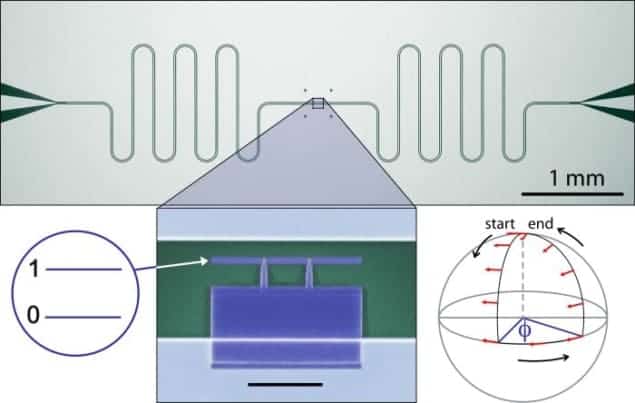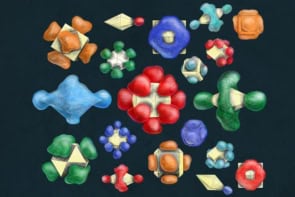
An international team of physicists is the first to show how information can be stored and manipulated in a solid-state quantum bit using “Berry’s phase” – an esoteric geometrical property of a quantum system.
The team controlled the Berry’s phase of paired electrons in a tiny piece of superconductor by exposing it to pulses of microwave radiation. The breakthrough could help physicists overcome a major barrier to practical quantum computing – the tendency of quantum bits to lose their quantum information content rapidly over time.
If a classical particle such as a stone undergoes a cyclic process – it is heated slightly and then cooled to its original temperature, for example – there is no way of telling from the cooled stone how it was heated, or even if it was heated at all. However, the same does not apply to quantum particles such as electrons, which retain some “memory” of the path taken in a cyclic process. This memory is in the form of a difference in phase between the initial and final quantum states and was first proposed by Michael Berry in 1984.
Berry’s phase is a “geometrical” effect that occurs in the abstract space defined by the orthogonal quantum states of a system. A key property of Berry’s phase is that it is not dependent on the path taken through this space, but only on the area enclosed by the loop. It turns out that this could be very useful to those designing quantum computers in which data are stored and processed in terms of quantum bits (or qubits) of information.
This is because phase plays an important role in quantum information, and manipulating the phase of a qubit corresponds to performing a logical operation. By cycling the system around a closed loop, Berry’s phase, and hence geometry, can be used to perform calculations.
A shaky hand
The manipulation of any qubit requires contact with the outside world. No matter how carefully this is done, the qubit is subjected to small amounts of noise, which could eventually destroy the quantum nature of the qubit, rendering it useless. However, the effect of noise on manipulating the Berry’s phase of a qubit can be likened to drawing a circle with a shaky hand – as long as the curve joins up and encloses the correct area, the manipulation of the qubit will be sound.
Quantum operations based on Berry’s phase have already been achieved in nuclear magnetic resonance and trapped-ion systems. However, these are large and unwieldy technologies and many physicists believe that it will be difficult to assemble them into practical quantum computers. However, solid-state qubits based on superconductors could, in principle, someday be miniaturized and mass-produced.
Now, Peter Leek and colleagues at ETH Zürich along with researchers in Canada and the US have demonstrated the first solid-state qubit based on Berry’s phase. Their results are reported today in Sciencexpress .
Aluminium qubit
The team’s qubit is a micrometre-sized piece of aluminium, which is a superconductor at very low temperatures. In its lowest energy state the superconductor contains a certain number of paired electrons and its first excited state contains that number plus one pair.
The aluminium was placed at the centre of a millimetre long superconducting wire that functioned as a microwave resonator. The resonant frequency of the resonator was set to be very different from the transition frequencies of the qubit – which served to isolate the qubit from its surrounding environment. However, the resonant frequency changes slightly depending upon the state of the qubit, allowing the researchers to monitor the state of the qubit by injecting a single microwave photon into the resonator.
The team then applied a number of different microwave signals to the resonator. Each signal caused the qubit to follow a path that enclosed a different area. This resulted in a number of different angles of Berry’s phase, which were measured using the single-photon technique.
“This is important research and I am very happy that it has been done”, said Jiannis Pachos of the UK’s University of Leeds, who is a proponent of Berry’s phase for quantum computing. Pachos told physicsworld.com that the next step is for physicists to build a solid-state two-qubit logic gate based on Berry’s phase – something that has already been done for ion-trap qubits.
This, however could prove difficult: “The control of solid-state two-qubit systems is lagging behind other systems”, said Pachos. Peter Leek told physicsworld.com that the team “are thinking of ways to do this at the moment”.



